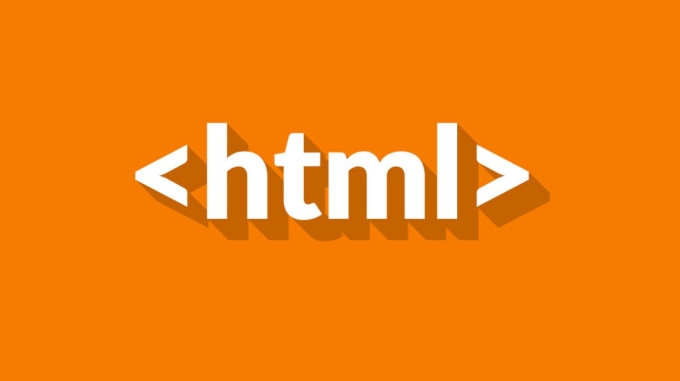The autocomplete attribute improves the form experience by controlling the browser's automatic filling behavior. Its core values include on, off and fine-grained types such as username and email; it is recommended to use username and current-password on the login page, and new-password on the registration page; fields such as address, phone and other fields can be optimized for address-level2 and tel to optimize the mobile keyboard pop-up; however, attention should be paid to the differences in browser compatibility, and if necessary, control the fill effect by modifying name/id or JavaScript.

The automatic completion function of the form input box seems to be a small detail, but if used properly, it can improve the user experience, but if used poorly, it may cause trouble. The autocomplete attribute in HTML is a key tool used to control this behavior.

Understand the basic role of autocomplete
The autocomplete attribute is used to tell the browser whether the fields should be automatically filled based on what the user has entered earlier. It has two common values: on and off . You can also set more specific values to match specific data types, such as username , email , current-password , etc.
-
autocomplete="on": Allows browser to automatically fill. -
autocomplete="off": prevents autofilling. - More fine-grained values such as
autocomplete="email"help the browser recognize the purpose of the field and improve accuracy.
In modern browsers, simply setting off is not always effective, especially for sensitive fields like passwords or credit card numbers. The browser may ignore this setting and prioritizes the user's convenience.

Use autocomplete in login and registration forms rationally
For login pages, setting up autocomplete correctly can help users complete operations faster:
-
It is recommended to write the user name input box as:

<input type="text" autocomplete="username">
The password input box should use:
<input type="password" autocomplete="current-password">
If it is a registration page, you need to distinguish between "current password" and "new password", you can use:
<input type="password" autocomplete="new-password">
This way the browser will know that this is the first time you set up your password, not the password of your existing account.
Sometimes you will find that even if autocomplete="off" is set, the browser will still fill in the content. At this time, you can try to change your ideas, such as giving the field an unusual name or id , or using hidden copy field techniques (such as putting a fake input box first to receive automatic fill).
Recommended settings for other scenarios of the form
In addition to login related fields, other types of input can also improve efficiency through autocomplete :
Address information:
- City:
autocomplete="address-level2" - Postal code:
autocomplete="postal-code"
- City:
telephone number:
<input type="tel" autocomplete="tel">
Email address:
<input type="email" autocomplete="email">
These fine-grained values not only help auto-fill, but also help the mobile side pop up the right keyboard type and improve the experience on mobile devices.
Pay attention to compatibility and actual results
Although many autocomplete values are defined in the HTML standard, the degree of support for different browsers varies slightly. Especially Safari and mobile browsers, they will have their own logic in some fields.
Several practical suggestions:
- Test the autofill behavior under different browsers, and do not rely solely on documentation instructions.
- For fields that must be disabled, you can try dynamically modifying the
autocompletevalue, or clearing the initial value with JavaScript. - If you find that a field is incorrectly filled with content, check whether its
name,idandautocompleteare consistent.
Sometimes, the problem is not the code itself, but the browser remembers the user's historical input method. Therefore, it is best to clear the browser history and try again when testing.
Basically that's it. Using autocomplete rationally can make the form filling smoother, but you can't rely entirely on it. After all, each user's usage habits and browser behavior are different.
The above is the detailed content of HTML `autocomplete` Attribute Best Practices. For more information, please follow other related articles on the PHP Chinese website!

Hot AI Tools

Undress AI Tool
Undress images for free

Undresser.AI Undress
AI-powered app for creating realistic nude photos

AI Clothes Remover
Online AI tool for removing clothes from photos.

Clothoff.io
AI clothes remover

Video Face Swap
Swap faces in any video effortlessly with our completely free AI face swap tool!

Hot Article

Hot Tools

Notepad++7.3.1
Easy-to-use and free code editor

SublimeText3 Chinese version
Chinese version, very easy to use

Zend Studio 13.0.1
Powerful PHP integrated development environment

Dreamweaver CS6
Visual web development tools

SublimeText3 Mac version
God-level code editing software (SublimeText3)
 Implementing Clickable Buttons Using the HTML button Element
Jul 07, 2025 am 02:31 AM
Implementing Clickable Buttons Using the HTML button Element
Jul 07, 2025 am 02:31 AM
To use HTML button elements to achieve clickable buttons, you must first master its basic usage and common precautions. 1. Create buttons with tags and define behaviors through type attributes (such as button, submit, reset), which is submitted by default; 2. Add interactive functions through JavaScript, which can be written inline or bind event listeners through ID to improve maintenance; 3. Use CSS to customize styles, including background color, border, rounded corners and hover/active status effects to enhance user experience; 4. Pay attention to common problems: make sure that the disabled attribute is not enabled, JS events are correctly bound, layout occlusion, and use the help of developer tools to troubleshoot exceptions. Master this
 Configuring Document Metadata Within the HTML head Element
Jul 09, 2025 am 02:30 AM
Configuring Document Metadata Within the HTML head Element
Jul 09, 2025 am 02:30 AM
Metadata in HTMLhead is crucial for SEO, social sharing, and browser behavior. 1. Set the page title and description, use and keep it concise and unique; 2. Add OpenGraph and Twitter card information to optimize social sharing effects, pay attention to the image size and use debugging tools to test; 3. Define the character set and viewport settings to ensure multi-language support is adapted to the mobile terminal; 4. Optional tags such as author copyright, robots control and canonical prevent duplicate content should also be configured reasonably.
 Best HTML tutorial for beginners in 2025
Jul 08, 2025 am 12:25 AM
Best HTML tutorial for beginners in 2025
Jul 08, 2025 am 12:25 AM
TolearnHTMLin2025,chooseatutorialthatbalanceshands-onpracticewithmodernstandardsandintegratesCSSandJavaScriptbasics.1.Prioritizehands-onlearningwithstep-by-stepprojectslikebuildingapersonalprofileorbloglayout.2.EnsureitcoversmodernHTMLelementssuchas,
 HTML for email templates tutorial
Jul 10, 2025 pm 02:01 PM
HTML for email templates tutorial
Jul 10, 2025 pm 02:01 PM
How to make HTML mail templates with good compatibility? First, you need to build a structure with tables to avoid using div flex or grid layout; secondly, all styles must be inlined and cannot rely on external CSS; then the picture should be added with alt description and use a public URL, and the buttons should be simulated with a table or td with background color; finally, you must test and adjust the details on multiple clients.
 How to associate captions with images or media using the html figure and figcaption elements?
Jul 07, 2025 am 02:30 AM
How to associate captions with images or media using the html figure and figcaption elements?
Jul 07, 2025 am 02:30 AM
Using HTML sums allows for intuitive and semantic clarity to add caption text to images or media. 1. Used to wrap independent media content, such as pictures, videos or code blocks; 2. It is placed as its explanatory text, and can be located above or below the media; 3. They not only improve the clarity of the page structure, but also enhance accessibility and SEO effect; 4. When using it, you should pay attention to avoid abuse, and apply to content that needs to be emphasized and accompanied by description, rather than ordinary decorative pictures; 5. The alt attribute that cannot be ignored, which is different from figcaption; 6. The figcaption is flexible and can be placed at the top or bottom of the figure as needed. Using these two tags correctly helps to build semantic and easy to understand web content.
 What are the most commonly used global attributes in html?
Jul 10, 2025 am 10:58 AM
What are the most commonly used global attributes in html?
Jul 10, 2025 am 10:58 AM
class, id, style, data-, and title are the most commonly used global attributes in HTML. class is used to specify one or more class names to facilitate style setting and JavaScript operations; id provides unique identifiers for elements, suitable for anchor jumps and JavaScript control; style allows for inline styles to be added, suitable for temporary debugging but not recommended for large-scale use; data-properties are used to store custom data, which is convenient for front-end and back-end interaction; title is used to add mouseover prompts, but its style and behavior are limited by the browser. Reasonable selection of these attributes can improve development efficiency and user experience.
 How to handle forms submission in HTML without a server?
Jul 09, 2025 am 01:14 AM
How to handle forms submission in HTML without a server?
Jul 09, 2025 am 01:14 AM
When there is no backend server, HTML form submission can still be processed through front-end technology or third-party services. Specific methods include: 1. Use JavaScript to intercept form submissions to achieve input verification and user feedback, but the data will not be persisted; 2. Use third-party serverless form services such as Formspree to collect data and provide email notification and redirection functions; 3. Use localStorage to store temporary client data, which is suitable for saving user preferences or managing single-page application status, but is not suitable for long-term storage of sensitive information.
 Implementing Native Lazy Loading for Images in HTML
Jul 12, 2025 am 12:48 AM
Implementing Native Lazy Loading for Images in HTML
Jul 12, 2025 am 12:48 AM
Native lazy loading is a built-in browser function that enables lazy loading of pictures by adding loading="lazy" attribute to the tag. 1. It does not require JavaScript or third-party libraries, and is used directly in HTML; 2. It is suitable for pictures that are not displayed on the first screen below the page, picture gallery scrolling add-ons and large picture resources; 3. It is not suitable for pictures with first screen or display:none; 4. When using it, a suitable placeholder should be set to avoid layout jitter; 5. It should optimize responsive image loading in combination with srcset and sizes attributes; 6. Compatibility issues need to be considered. Some old browsers do not support it. They can be used through feature detection and combined with JavaScript solutions.







